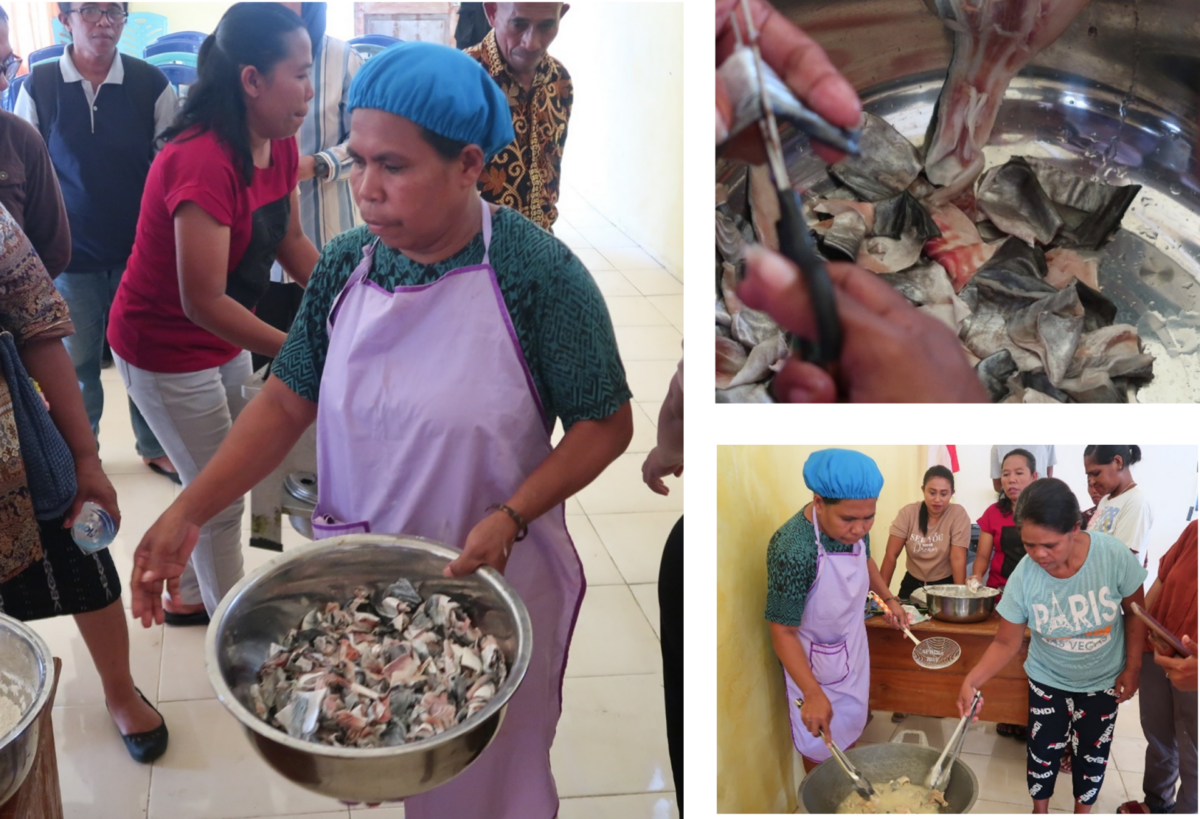In Dobo, the capital of the Aru Archipelago, The ATSEA-2 Project recently initiated coordination and training on the processing of fish skin waste produced by local fish companies. Together with the Aru Department of Fisheries and CV Niaga Indonesia, this collaboration forms part of wider efforts to reduce fish processing waste and create added value in the management of marine resources using an Ecosystem Approach to Fisheries Management (EAFM). Red snapper and shrimp are the main commodities targeted for EAFM interventions in Aru. The training and coordination were conducted in two different sessions, both of which were held this February in Dobo, Aru Archipelago District.
The first session, conducted on 23 February 2023, focused on fish skin waste processing training. The aim was to support household income for fisheries workers by promoting alternative livelihoods that utilise local resources, through skills training for fishers’ wives and other local women. The training was attended by 20 coastal women from Wangel Village, along with members of the Protestant Church Council of Wangel and Marbali, a fisheries extension officer, members of the Aru Department of Development of Disadvantaged Regions and Transmigration Agency, and Aru’s Department of Trade. Aru’s Department of Health was also involved in the training, in order to assess the suitability of good processing procedures and ensure good nutritional content in the resulting products.

Mutia, the director of CV Niaga Indonesia was the trainer for the session together with Sila Kartika Sari, ATSEA-2 Field Facilitator for the Aru Archipelago. They were supported by staff from the Fisheries Agency. Participants were provided with raw materials and then taught how to use basic and affordable ingredients such as wheat flour, cornstarch and spices to make fish skin into chips and snacks. At the end of the training, the participants successfully created fish skin chips and packaged the products, which were then showcased in a coordination meeting.
The second session, held on 28 February 2023, was a coordination meeting conducted as part of follow-up activities regarding fish skin waste training. The objective of the meeting was to bring together stakeholders from different levels across the Aru Archipelago and foster collaboration towards enhancing household income. The meeting was attended by nine local government agencies, three central Ministry of Marine Affairs and Fisheries (MMAF) agencies working in Dobo, three village officials, two church councils, two coastal women’s groups and several government partners.

During the meeting, participants discussed ways to leverage advanced development techniques that could significantly enhance the value added and sales potential of the region’s fisheries products. In addition to processing fish skin waste, Namara village’s shrimp paste and Apara Village’s Balobo salted dry fish have also been identified as important targets for alternative livelihoods, with the potential for development at the next level for communities in Aru. These products are mainly processed by women who are wives of fishermen living along the coast. Providing alternative livelihoods will not only support household income in the fisheries sector, but also contribute to the effective management of the Southeast Aru Marine Protected Area (MPA), since Apara Village is one of the nearest villages and a user of this MPA. By developing alternative livelihood strategies, these communities can maximise the use of available resources, while preventing overexploitation of marine resources in the area.
The discussions also highlighted the need for collaboration between stakeholders to maximise the potential of local fishery resources and turn waste into an added-value product. Various stakeholders, including local government, church councils and village officials, have agreed to help expedite the process of obtaining home industry product permits (PIRT) for the three processed products. They also prioritised further training to improve the products, along with mentoring on Good Manufacturing Practice (GMP) and product labelling. Moving forward, a commitment in the form of a Memorandum of Understanding (MoU), monitored by the district government, is still needed to ensure the joint contribution and commitment of all parties in realising the Aru Archipelago micro fisheries products’ national competitiveness. This will strengthen the sustainable economic impact and recognition of women’s roles in the productive sector of marine and fisheries.
The ATSEA-2 Project’s initiative to reduce fish processing waste and turn it into an added-value product is an important step towards achieving sustainable fisheries management in the Aru Archipelago. The initiative is part of wider efforts to improve marine resource management using an EAFM in the Arafura Timor Seas (ATS) region.
By Sila Kartika Sari


